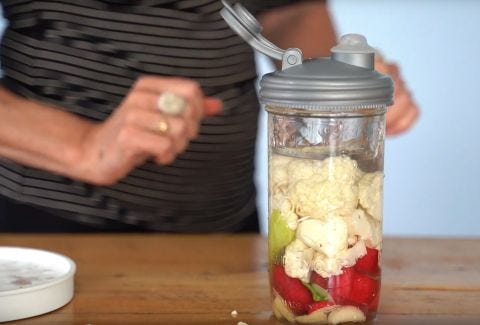The "Scoop" on Himalayan Salt
Included in our Fermenting Starter Kit, Himalayan pink salt is ideal for fermenting. Full of natural vitamins and minerals, it both flavors your ferments and provides a whole host of benefits. Read on to learn more, or grab a kit and start fermenting!
All About Pink Himalayan Salt
(Excerpt from Healthy and Natural World)
Himalayan salt is often marketed as coming from a non-polluted area deep in the Himalayas. The salt is actually harvested at the foot of the Himalayas, in a rock salt mine in Pakistan, which is considered to be the second largest mine in the world.
Himalayan salt, known as ‘white gold’ in its region of origin, contains 84 natural elements and minerals that are vital to our health, including magnesium, potassium, calcium, chloride, phosphorus, and iron. The salt’s signature pink color is a result of a tiny amount of iron oxide (rust). Zinc, selenium, iodine, and copper are also present in trace quantities.
Generally speaking, Himalayan salt is considered a healthy salt because no chemicals or additives are added to it, and it’s a naturally occurring substance.
Usually, this salt is sold as coarse grains, but you can also find it finely grained or as large blocks, which can be used as a unique way to serve your culinary specialties. No matter the form, the prized mineral benefits are always there.
More Facts about Himalayan Salt:
• Himalayan salt (a mineral-rich dry salt) is a popular choice for making fermented vegetables. The salt you use can change the flavor of your fermented vegetables and sauerkraut. Salts depleted of their minerals and that are high in sodium chloride like table salt have a harsher flavor, while mineral-rich salts have a more mild, sweet flavor.
• Since Himalayan salt is a naturally formed salt, it contains many nutrients including magnesium, potassium, and calcium.
• The fermentation process makes these minerals more biodegradable, meaning your body can more easily absorb all the mineral goodness.
• The darker the color of the crystals, the more minerals are contained, since it is the minerals that create the salt’s signature coloring.
Why do we use salt for fermentation in the first place? (Source: Sandor Katz, Wild Fermentation)
• Strengthens the ferment's ability to eliminate any potential pathogenic bacteria present
• Adds to the flavor
• Acts as a natural preservative, which may be necessary if you're making large batches that need to last for a larger portion of the year
• Lowers the enzymatic digestion of the vegetables, leaving them crunchier.
• Inhibits surface molds.





